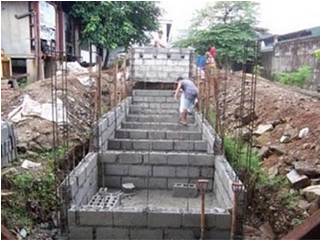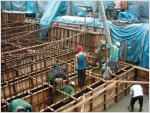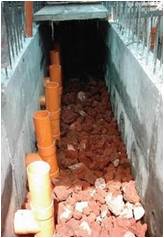Practitioner's Tool / Anaerobic Baffled Reactor (ABR) 2
An anaerobic baffled reactor (ABR) is a tank with several compartments that is designed to reduce the organic and suspended matter in the wastewater by about 70%. Raw wastewater enters the ABR tank through the inlet structure, which directs the flow to the bottom of the first compartment. Due to the nature of wastewater under anaerobic conditions, a granulated sludge blanket is formed. As the wastewater flows up through the sludge granules, the solids are trapped in the sludge blanket where anaerobic bacteria consume the organics as food. The result is that a partially clarified effluent flows up over the baffle to the next compartment where the same action is performed. In each subsequent compartment, the effluent is clarified further until the final compartment, where the anaerobic effluent is relatively free of suspended solids and the biochemical oxygen demand level is greatly reduced. The technology is inexpensive, does not require electricity, is relatively simple to operate and can be constructed with local materials and labor.
ABRs are relatively simple to design. Some designers use transfer openings in the baffle walls to direct the flow from one compartment to the next. Other designers use pipes that collect the effluent from the top of one compartment and deliver it to the bottom of the next compartment. With any design,ensure that pipe or transfer openings are set level to avoid short circuiting.
Features of ABR Systems
When adequately reinforced, ABR systems may be installed under driveways, parking areas, play grounds or other open spaces. The tanks are usually constructed completely underground with manholes or access ports as the only protrusions. ABRs, being passive systems requiring no electricity to operate, are truly low-cost technologies. However, ABRs, while more efficient than septic tanks, will still require secondary treatment to provide a quality of effluent suitable for discharge. Secondary treatment may be in the form of soils treatment (leach trenches if soils are adequate), constructed wetlands, sand or media filtration. Some designers will combine ABRs with mechanical treatment such as sequencing batch reactors to provide a highly treated wastewater effluent.
The Tank
Most ABR designs provide for a tank volume of at least one day retention time. ABR tanks may be constructed out of hollow concrete block or poured-in-place concrete.
Hollow block construction. Contractors should first prepare the site by excavating the tank hole to the proper depth plus extra depth to accommodate bedding material, typically 1/4 to 1/3 meter of compacted sand, gravel or aggregate base. Forms are set on top of the bedding material and vertical rebar installed at every other block. Once the floor is poured and set, the block-laying may proceed. Contractors will mortar the blocks in place and use bond beams with horizontal rebar every other row. When all of the blocks are laid, the cells will be filled with grout and allowed to harden. Due to the many joints, some plastering or sealing with tar or mortar on the tank inside is usually required. In high groundwater areas, sealing the outside of the tank to prevent infiltration is beneficial.
Poured-in-place tank construction. For larger projects, or systems that must support heavy loads, pouring concrete as a monolithic structure is often preferable to concrete blocks. Poured-in-place tanks are started in the same manner as block tanks: first excavate the tank hole with extra depth for bedding material then install the forms and rebar as per the specifications. Baffles and transfer pipes are also set using forms. Note that for extra load-bearing capabilities, thickened columns and slabs are often used. When the forms and steal are in place, pour the concrete and allow it to harden. Concrete will harden to about 90% of its total strength after 7 days, unless additives are used to quicken the hardening. Such concrete mixes, called high-early, may be used when backfilling must be accomplished quickly.
Leak Testing and Backfilling Procedures
Take great care when backfilling around the tank. Too much weight from the soil can crush the tank. Also, it is much easier to leak test and plug leaks before the tank is completely backfilled.
To test for leaks and backfill:
- Before any backfilling or leak testing, make sure the tank has set for a minimum of 7 days (unless you used a high-early concrete mix). If the tank design calls for plastering or waterproofing with tar or mortar, apply these materials and let dry.
- Fill the tank with one meter of water and examine the outside of the tank for any visible leaks or seeps in the bottom half of the tank. Repair leaks with waterproof cement or other approved materials.
- Once any leaks or seeps are repaired, backfill around the tank to the depth just below the level of the water in the tank. This will help equalize the pressure that the weight of the water exerts on the tank walls. Make sure that backfill material is free of large rocks or boulders. Gently place the soils material around the tank, taking care to keep sharp rocks away from the concrete.
- Add some water to the soils material you have just placed around the tank and compact using manual tampers. Never use mechanical tampers as too much compaction may break the tank.
- Fill the tank with water to the top. As before, check for leaks or seeps in the top half and repair as needed.
- Backfill the rest of the way with clean soil and manually compact as above. Mound soil slightly around the tank to shed surface water and to avoid ponding of surface water over the tank.
- Check the soils over the tank frequently. Over the weeks or months after tank installation, some soils settling will occur. Fill depressions or fissures as soon as possible.
NOTE: As soon as possible after the tank has hardened, add water to the tank and begin the backfilling procedure. This provides weight that can counteract buoyancy forces. This is especially important in areas where groundwater is high or surface waters can fill in tank holes.




